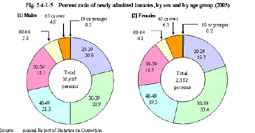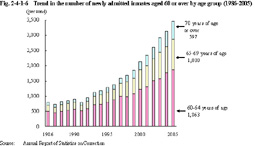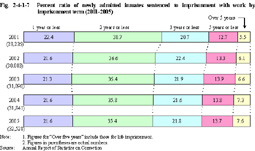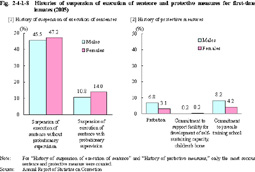| Previous Next Index Image Index Year Selection | |
|
|
4 Characteristics of newly admitted inmates (1) Age Fig. 2-4-1-5 shows the percent ratio of newly admitted inmates in 2005 by sex and by age group. The rate of 30 to 39 years old was the highest both for males and females.
Fig. 2-4-1-5 Percent ratio of newly admitted inmates, by sex and by age group (2005) Fig. 2-4-1-6 shows the trend of the number of newly admitted inmates aged 60 years or over by age group, over the last 20 years.The percentage of aged persons in newly admitted inmates has been on an upward trend. In 2005, 1,597 were 65 years of age or over, up by 240 from the previous year, and they accounted for 4.9% of the total, up by 0.6 points. Fig. 2-4-1-6 Trend in the number of newly admitted inmates aged 60 or over by age group (1986-2005) As of December 31, 2005, among the total of 67,423 inmates, those aged 60 or over was 7,837 (including 1,593 inmates aged 70 or over), accounting for 11.6% of the total (an increase of 0.1 point from the same day of the previous year) (Source: Annual Report of Statistics on Correction).(2) Type of offenses In examination of offenses committed by newly admitted inmates in 2005, the following five offenses had high percentages for male inmates: (1) theft (29.9%), (2) Stimulants Control Act violations (20.2%), (3) fraud (7.1%), (4) Road Traffic Act violations (6.4%), and (5) injury (5.1%). The following five offenses had high percentages for female inmates: (1) Stimulants Control Act violations (35.2%), (2) theft (29.7%), (3) fraud (7.8%), (4) homicide (4.3%), and (5) Road Traffic Act violations (3.1%) (See Appendix 2-6).
For male inmates, theft accounted for the highest percentage, followed by Stimulants Control Act violations. This pattern has continued since 1998. For female inmates, the percentage for Stimulants Control Act violations has been the highest since 1978. (3) Type of sentence and term of imprisonment By type of sentence of newly admitted inmates in 2005, 99.2% (32,528 inmates) were sentenced to imprisonment with work, and the rest of them were sentenced to imprisonment without work (0.7% or 243 inmates), or misdemeanor imprisonment without work (0.1% or 17 inmates). A death penalty was executed for one inmate in 2005.
Fig. 2-4-1-7 shows the percent ratio of newly admitted inmates sentenced to imprisonment with work by imprisonment term over the last five years. Percent ratio of inmates sentenced to imprisonment for "over one year but two years or less" was the highest of all every year, but has been on a declining trend, and that of inmates sentenced to imprisonment for over two years has been on an increasing trend (See Appendix 2-10). Fig. 2-4-1-7 Percent ratio of newly admitted inmates sentenced to imprisonment with work by imprisonment term (2001-2005) (4) History of offenses The percentage of first-time inmates (persons imprisoned for the first time; hereinafter the same) in all those newly admitted has been over 50% since 2001, and was 50.5% in 2005 (See Appendix 2-8 for the number of times of imprisonment of newly admitted inmates by type of offense).
Fig. 2-4-1-8 shows the histories of suspension of execution of sentence and protective measures of the 16,573 first-time inmates (15,040 males and 1,533 females) newly imprisoned in 2005. Fig. 2-4-1-8 Histories of suspension of execution of sentence and protective measures for first-time inmates (2005) |



